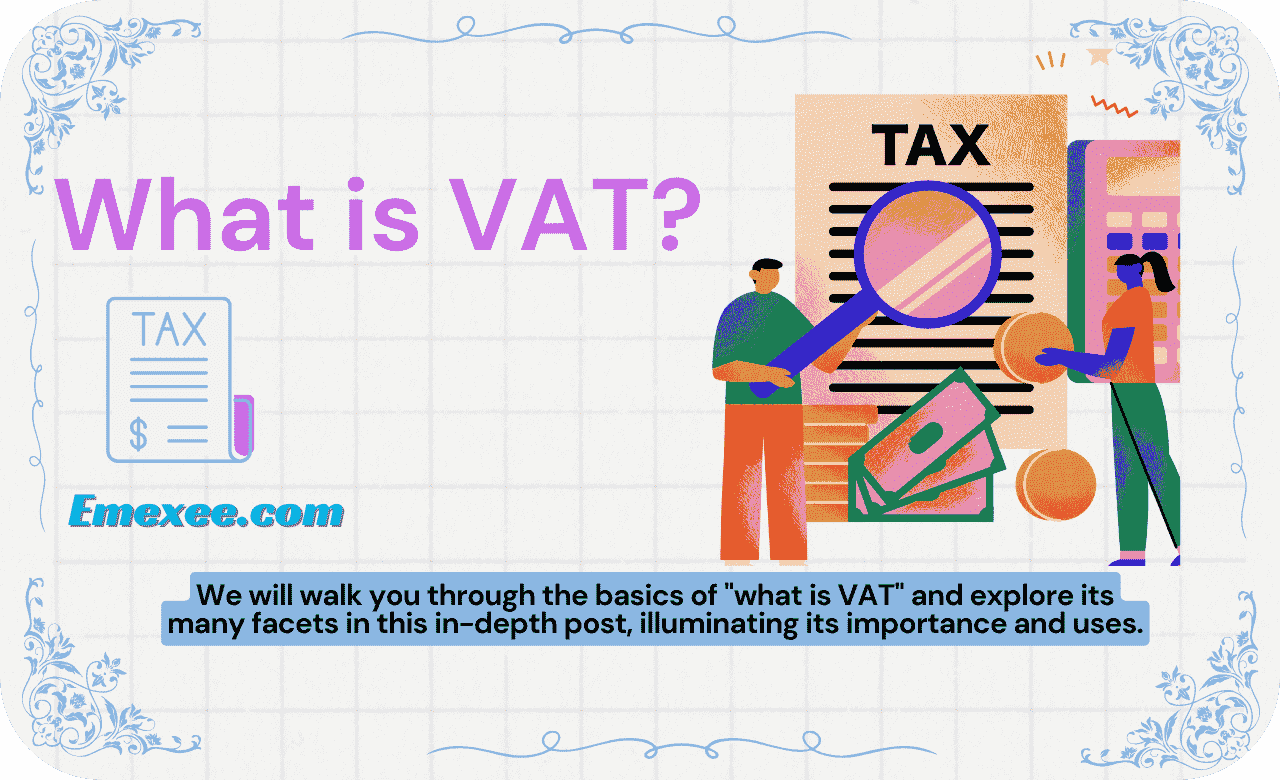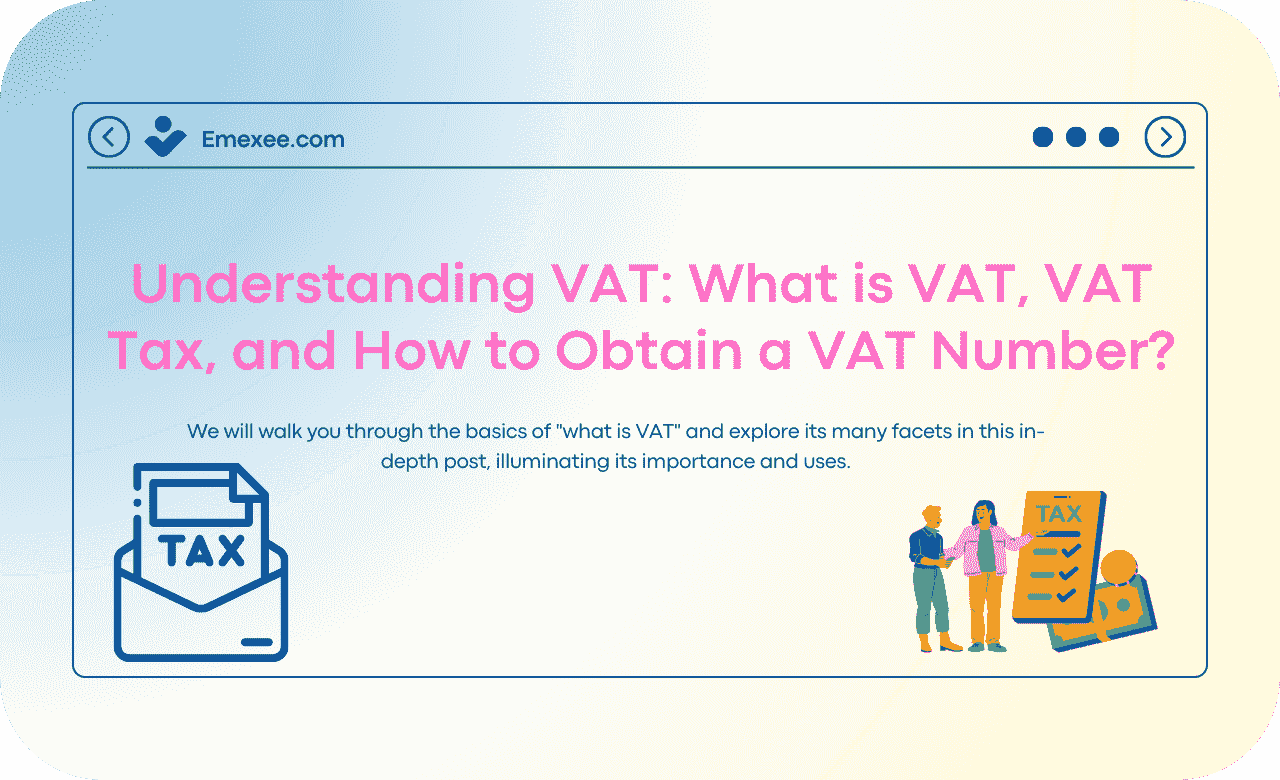What is VAT?
Understanding VAT: What is VAT, VAT Tax, and How to Obtain a VAT NUMBER?
A basic understanding of “what is VAT” is essential in the connected world of financial transactions and economic activity of today. This post aims to clarify the confusing meaning of “what is VAT” by providing information on its definition, uses, and nuances related to this crucial financial idea.
Introduction
1. Definition of VAT
Basically, “VAT (Value Added Tax),” often known as “what is VAT,” is a consumption tax that is applied to products and services throughout the whole manufacturing and distribution process. “What is VAT” is an indirect tax as it shifts the cost to the final customer, unlike other taxes.
2. Full Form of VAT: What Does VAT Stand For?
Value Added Tax is what “VAT” stands for. It is a consumption tax that is paid for by the final customer and is imposed at every point of production and distribution.
3. Importance of understanding VAT
The complexities of “what is VAT” become more important when companies grow internationally. A thorough comprehension of “what is VAT” promotes effective financial management while preventing any legal issues and ensuring compliance.
What is VAT?
1. VAT explanation
The complex architecture of “VAT” captures value added at production, distribution, and retail stages of the supply chain. “VAT” seeks to fairly spread the tax burden across the whole production and consuming process by imposing a tax on the added value.
2. Distinction from other taxes
It’s critical to differentiate “VAT” from other taxes, such sales tax. “VAT” offers a more complete approach to taxes, covering several phases of production and distribution, whereas sales tax is only enforced at the moment of sale.
3. Global relevance
“VAT” is not limited to any one area; rather, it is used in numerous nations around the globe. Companies that trade internationally need to understand the global implications of “what is VAT,” as following various “what is VAT” laws becomes necessary.
Simplified Your VAT Calculations with Our Free VAT Calculator Tools!
To experience the simplicity of our free VAT Calculator Tools for accurate and hassle-free VAT calculations, visit https://emexee.com/vat-calculator/.
How to Calculate VAT: Unveiling the Formula
1. VAT Calculation Formula:
Apply the below technique to ascertain VAT: (Original Price × VAT Rate) / 100 equals the VAT amount. By utilizing the original price and the relevant VAT rate, businesses may use this approach to compute the amount of VAT.
2. Excel VAT Calculation: A Detailed How-To
Step 1: Put the original price in one box and the VAT rate in another.
Step 2: In a third cell, apply the formula: `=Original Price x (VAT Rate/100) `.
Step 3: The result is the VAT amount. Add this to the original price for the total.
How Does VAT Work?
1. Calculation process
The final selling price of a good or service is used to compute “VAT.” To comply with legal obligations, businesses need to keep meticulous records of their “VAT” transactions and report them properly.
2. Application in different industries
Different industries, including manufacturing, retail, and services, implement “what is VAT” differently. Exploring these variations provides valuable insights into the practical application of “what is VAT” across sectors.
VAT Tax: Unveiling the Complexity
1. Understanding VAT Tax Implications
Delving deeper into the tax implications of “what is VAT” sheds light on its complexities. Businesses must navigate these intricacies to ensure compliance.
2. Common misconceptions
“VAT” is often surrounded by misconceptions. Addressing and debunking these myths clarifies the true nature of this tax.
Acquiring a VAT Number
1. Significance of a VAT number
For enterprises, obtaining a “VAT number” is an essential step. It functions as a distinctive identity, enabling smooth transactions under the “what is VAT” framework and precise monitoring and reporting.
2. Steps to obtain a VAT number
The process of acquiring a “VAT number” involves specific steps. Comprehending and adhering to these procedures expedites the registration procedure for enterprises, guaranteeing adherence to the “what is VAT” guidelines.
Getting Around the VAT Landscape
1. Complying with VAT regulations
Getting around the VAT environment requires adherence to regulations. Businesses must stay informed and comply with the ever-evolving “what is VAT rules.
2. Challenges and solutions
Identifying challenges associated with “what is VAT” and implementing effective solutions ensures smooth business operations.
Benefits of VAT
1. Economic impact
VAT plays a pivotal role in the economic landscape. Exploring its impact on government revenue and public services provides a holistic view.
2.Streamlining business operations
For businesses, “what is VAT” offers benefits beyond revenue generation. Streamlining operations and optimizing financial processes are among the tangible advantages.
Common VAT Scenarios
1. VAT in e-commerce
The digital era has completely changed how business is done. Examining how “what is VAT” applies to e-commerce provides insights into this dynamic sector.
2. VAT on international transactions
Cross-border transactions introduce additional complexities. Understanding how “what is VAT” applies in international scenarios is crucial for global enterprises.
Demystifying the VAT Jargon
1.Key terms explained
Demystifying VAT jargon is crucial for individuals and businesses alike. Clear explanations of key terms enhance comprehension.
2. Simplifying complex concepts
Breaking down complex concepts associated with “what is VAT” ensures that readers, regardless of their background, can grasp the essentials.
How to Use VAT to Your Advantage
1. Strategic Approaches
Beyond mere compliance, businesses can strategically leverage “what is VAT” for competitive advantages. Exploring these approaches unveils opportunities for growth.
2. Maximizing benefits
Identifying and maximizing the benefits of “what is VAT” requires a proactive approach. This section explores ways businesses can optimize their “what is VAT” strategies.
The Human Side of VAT
1. Real-word examples
Examining real-world scenarios showcases the human impact of “what is VAT”. Understanding how individuals are affected adds a personal touch to the narrative.
2. Impact on individuals
Beyond business, “what is VAT” influences individuals’ daily lives. Delving into this aspect provides a comprehensive view of what is VAT’s broader implications.
Staying Informed: VAT Updates
1. Changes in VAT regulations
Since VAT legislation are subject to change, it is essential to stay informed. This implies that for organizations, it’s critical to closely monitor upgrades in order to maintain compliance and avoid any fines. Staying informed about these developments guarantees that your firm operates without any unplanned disruptions.
2. Resources for staying updated
Identifying reliable resources for “what is VAT” updates ensures businesses are well-equipped to adapt to regulatory changes seamlessly.
Tips for Simplifying VAT Processes
1. Automation tools
Technology offers solutions to simplify “what is VAT” processes. Exploring automation tools can significantly reduce the administrative burden associated with “what is VAT” compliance.
2. Expert advice
Seeking expert advice on “what is VAT” matters is a prudent strategy. Understanding when and how to consult professionals ensures accurate decision-making.
Navigating VAT Challenges
Addressing common issues
Common challenges in “what is VAT” compliance can disrupt business operations. Proactively addressing these issues helps businesses mitigate risks and maintain seamless compliance with “what is VAT” regulations.
You’re Questions and Their Answer About “What is VAT” (FAQ):
1. What's the Deal with VAT?
Alright, so VAT, which stands for Value Added Tax, is like a little extra something-something tagged onto the stuff we buy and use. Picture it this way: as a product goes through its life cycle, there’s this extra cost sprinkled on it at each stage. The cool part? The person who ends up buying it is the one tossing in this extra cash. VAT ensures that everyone who played a role in making and selling that product gets a fair cut of this tax, giving credit where credit’s due at every step.
2. How is VAT Different from Other Taxes, Like Sales Tax?
VAT is like a tax detective that follows a product everywhere – from making it to selling it. Unlike sales tax, which only shows up when you buy something, VAT is there every step of the way. It even charges a bit more at each stage. This extra amount ensures that everyone who played a part in making and delivering the product pays their fair share. So, VAT is like a fairness tax that covers all the costs fairly.
3. Why is obtaining a VAT number important for businesses?
Businesses should make sure they have a VAT number. It’s a unique identity, which makes transactions easier within the VAT system. In addition to simplifying the procedures, ensuring regulatory compliance is ensured by having a VAT number which contributes to an efficient and precise financial management system.
4. What are the strategic uses of VAT for businesses?
In order to gain a competitive advantage, businesses may deliberately exploit VAT beyond the limits of compliance. More efficient financial processes and streamlining of operations can result from this strategic use. In order for enterprises to optimize overall performance and efficiency while complying with the regulatory requirements, it is important that they have a thorough understanding of VAT.
5. What are the essential guidelines for simplification of VAT procedures?
To reduce the cost of compliance and improve decision making, consider VAT automation solutions. In order to increase efficiency and ensure compliance with the legislation, companies need to seek expert guidance on VAT issues.
Conclusion
Finally, understanding VAT, VAT and obtaining a VAT number is essential for business as it deals with the world’s changing landscape. In addition to compliance, businesses can increase their activities, effectively manage their finances, and gain a competitive edge in the international market.
It is essential to remain well aware of the constantly changing VAT landscape, embrace automation and seek advice from professionals in order to be successful. In the dynamic field of international trade, this adaptability is still crucial for long term success. Businesses are positioning themselves not only for compliance, but also for sustained growth and excellence, by constantly developing strategies and keeping up to date with the subtleties of VAT.



